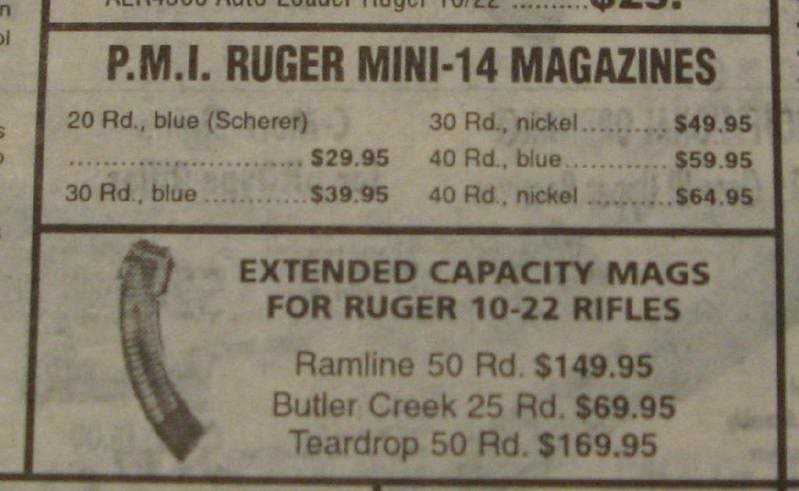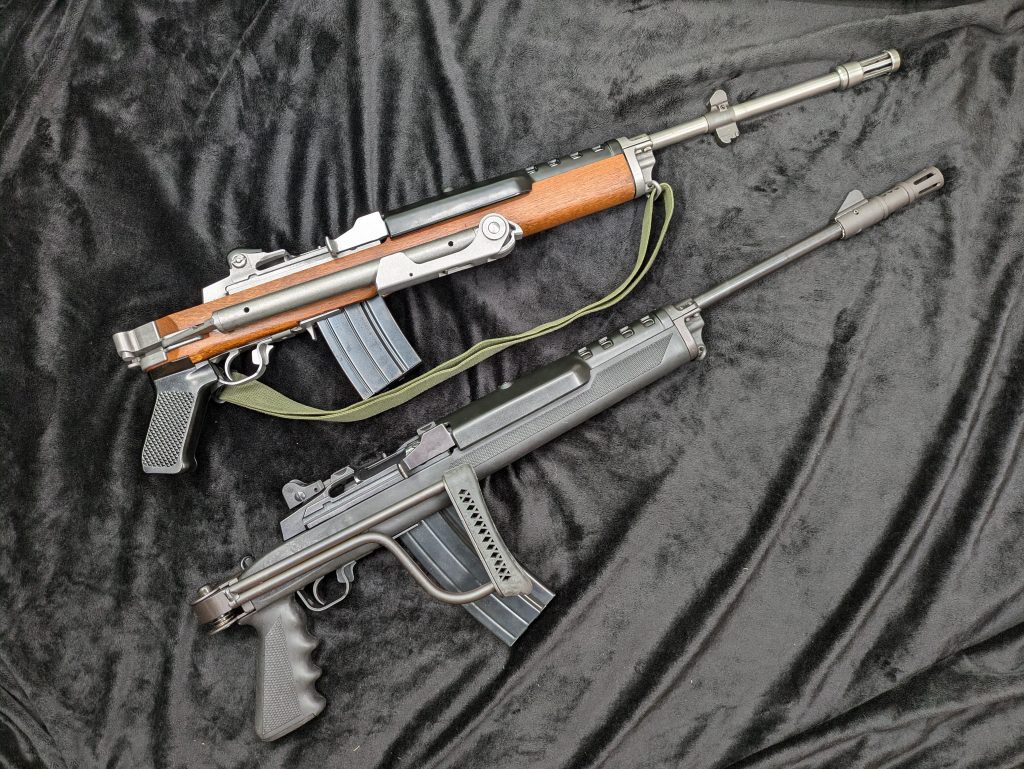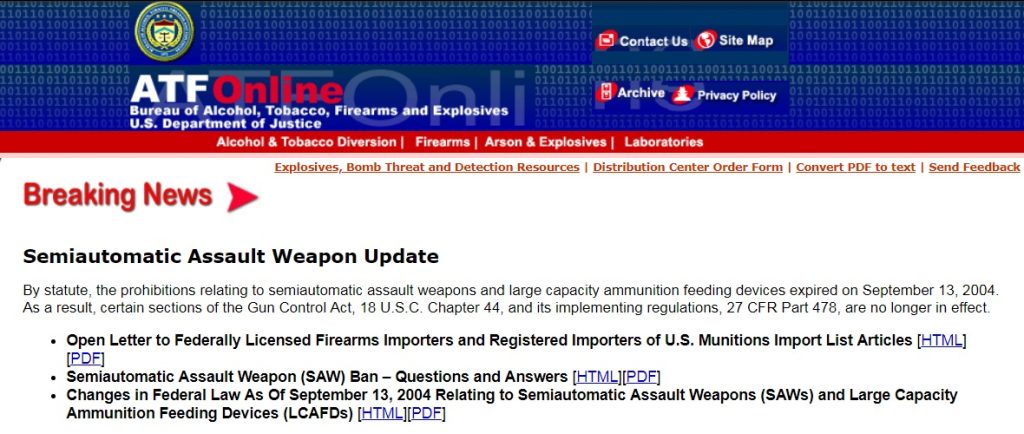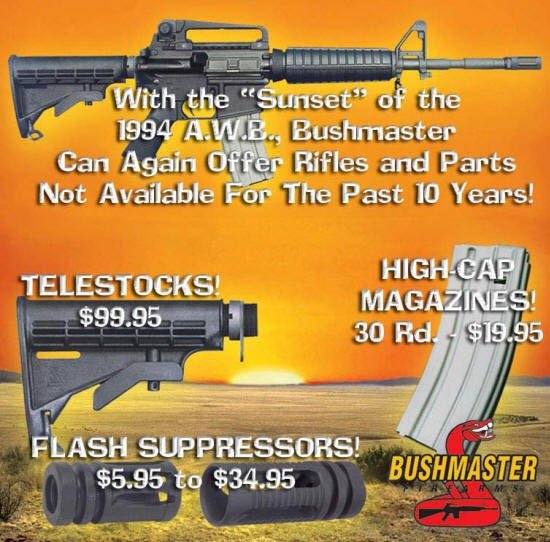
As we covered in Part 1, the first half of the 1990s was a dark time for gun owners. Anti-gunners and their political allies had momentum, ramming gun control down the throats of Mr. & Mrs. America. Bill Clinton, Nancy Pelosi, Dianne Feinstein, and others were giddy at the progress they’d made in disarming everyday people. But as I said at the end of the first article, it’s always darkest before the dawn.
Gun owners across the nation had been energized to fight back against the despotic machine that was the Clinton Administration. Once again, the disarmament movement backfired, and gun ownership actually exploded in the 1990s, specifically because the government told people they couldn’t own some firearms.
Uncle Sam told average Americans that features like these were somehow uniquely dangerous . . .

But while manufacturers responded by offering ban-compliant rifles without the scary features, that only made American want those feature more.
The ban had affected pistols too. Companies and consumers decided that if they were limited to carrying only ten rounds, they’d shrink their guns and make them more concealable. That terrified the gun-grabbers as reflected in this July, 18, 2000 article from the Chicago Tribune titled Guns Foes Warn of ‘Pocket Rockets’.
The gun fits in the palm of your hand. It packs three times the power of its predecessors. It holds up to 10 bullets. It is what police call a “pocket rocket.”
The issue snagged the attention of U.S. Rep. Rod Blagojevich (D-Ill.), a champion of anti-gun legislation who on Monday said he would introduce a bill to ban the weapons. “These are new high-tech guns designed specifically for killing people,” he said during a news conference at the Dirksen Federal Building. “They have no real sport purpose, and they don’t do anything that enhances a gun collector’s collection.”
The weapons started gaining popularity in 1994, and today, virtually all major gun manufacturers produce them, said Tom Diaz, senior policy analyst at the center. Diaz also said the industry has promoted “pocket rockets”– a term coined by Austrian gun manufacturer Glock to market a small, high-powered pistol– in tandem with a wave of state laws that permit licensed people to carry concealed weapons.
If you’re limited to carrying only 10 rounds, why buy a G17 and have all that “wasted space?” As a result, guns the size of a Walther PPK or S&W J-Frame — but chambered in .380, 9mm, .40 S&W or even 10mm Auto — came on the scene. These unintended consequences scared the bejeezus out of the gun grabbers. But the industry and more importantly, the law-abiding public loved it.

It wasn’t, of course, all sunshine and roses. The American people had been hamstrung. The prices of pre-ban firearms and magazines rose, and it was hard for working-class Americans to be able to afford them.



As the decade of the ban marched on, prices for bre-ban magazines soared.

To this day, I have my pre-ban Ruger 10/22 magazines that I got as a kid. My father purchased them for me around 1995 as a gift. I recall him telling me to enjoy them, but don’t be rough on them because they were basically irreplaceable.

With the ban in place, you’d think that would have been it for quality magazines over 10rd. But in the words of Yoda, no…there is another [way] for John Q. Citizen to get their hands on newly manufactured non-neutered magazines and guns.
There was — as always — a carveout in the ban for law enforcement and military personnel to be able to buy non-compliant guns and magazines for work purposes. All buyers needed was an official note saying it was work-related. That was where the agency letterhead came in. If you were in law enforcement or the military or had a friend or family member in uniform, you could get new production guns and full capacity mags.
The way it worked was simple. Get a letter written on the agency’s stationary on it stating that the magazines and/or gun(s) being purchased from the dealer were for work purposes. Nothing in the Clinton ban said that once the items were privately purchased by an authorized party, they couldn’t be sold to someone else.
That’s how I got Ruger 20- and 30-round magazines for my Mini-14.

As a teenager, my father, who was a police officer, purchased them for himself. His agency supervisor approved the purchase since the department allowed private purchase patrol rifles for work use. Dad had the Mini-14 and later determined that an AR-15 was better suited for duty use. He then gifted me the “high capacity” magazines for my Mini-14s.

I knew a few other gun owners back in the day that got LEO/mil/gov use only marked magazines that way.

Plenty of non-neutered LEO-only magazines got into circulation thanks to local surplus stores and pawnshops near military bases. When the mags were pulled out of rotation due to wear and tear, resourceful soldiers, Marines, airmen, and sailors made sure they went to good homes.

The Beretta 92 was one of the guns that was extremely popular since there was an ample supply of both pre-ban and black-market LEO-only mags in circulation. Guns like the GLOCK 29 were popular because while it was a 10-round only gun, it was 10 rounds of 10mm Auto. The HK USP in .40 S&W was popular, but buying pre-ban mags wasn’t cheap.
There were, of course, some who abused the market conditions and charged obscene prices. But a lot of cops and service members did it at cost for the less fortunate. It was literally an underground railroad arming freedom-loving Americans.
And it drove the gun-grabbers insane.
Gun owners weren’t stupid. They came up with ways to nullify the ban as best they could. Here’s a 60 Minutes segment which originally aired in 1999 about how people were navigating around the ban.
Luckily for gun owners, the 10-year sunset provision was part of the bill that was signed into law. The ban never would have made it through Congress without a sunset clause. And through the hard work of gun owners and gun rights organizations like Gun Owners of America, the makeup of the federal government looked very different in 2004 with congressional Republican majorities and George W. Bush in the White House.
Gun owners were through the woods yet, though . . .
But through the hard work of gun owners and GOA the votes weren’t there to renew the ban and it died in Congress. So n September 13, 2004, ten years after it was signed into law, the ban expired. It was like the Berlin Wall had come down and freedom rang through the land.

Oh, my how companies, pro-gun organizations, and gun banners alike reacted.
The industry was finally able to once again sell what was verboten for the average citizen. Magazines, flash hiders, and telescoping stocks were suddenly falling like manna from heaven as wallets broke sound barriers as they opened.





Pro-gun organizations like Gun Owners of America were celebrating after a decade’s worth of hard work. Work that literally continued to the final minute. Since the anti-gunners were trying their hardest to still get the ban renewed.

The Civilian Disarmament Industrial Complex was apoplectic about the ban’s “temporary” expiration.


As we now know, the Clinton “assault weapons” ban was an entirely political exercise, one that had no practical effect at all on crime. It only really affected the law abiding. Even the gun grabbers admitted its failure after the ban ended.

The New York Times’ Lois Beckett wrote . . .
But in the 10 years since the previous ban lapsed, even gun control advocates acknowledge a larger truth: The law that barred the sale of assault weapons from 1994 to 2004 made little difference.
It turns out that big, scary military rifles don’t kill the vast majority of the 11,000 Americans murdered with guns each year. Little handguns do.

Violent crime had already begun to decline after its 1992 peak. The ban did virtually nothing to change that and violent crime continued to drop after the Clinton ban had expired.
My tastes and firearms purchasing habits have been shaped by the Clinton ban and I’m not alone. I see folks spend significant money on fancy muzzle brakes when, to me, a standard ten-dollar A2 flash hider is where it is at. Bayonet lugs, folding/collapsing stocks, and full 30-round magazines are important to me now. That is what guides my tastes even in the era of slick full-length free-floating handguards and space age muzzle devices.
The ban also had the effect of significantly increasing the popularity of the AR-15 platform rifle. Sales soared after the ban was lifted and it’s since become America’s most popular rifle. Current estimates are that Americans own about 25 million of them.
The lesson for anti-gunners and federal level Democrats should be that nothing makes an American want something more than the government telling them they can’t have it.
Though the fight is far from over. The assaults on our rights continue from the Civilian Disarmament Industrial Complex. But gun rights and gun ownership have dramatically changed since the ban, and they’ve changed for the better. Concealed carry and then permitless carry spread widely after the ban and we now have 29 permitless carry states.

In the end, I leave you with these words about the fight he had over the decades and the fight we have ahead.
Luis Valdes is a former law enforcement officer and detective, and is currently the Florida State Director, Outreach Director of Puerto Rico & US Virgin Islands, and National Spokesman for Gun Owners of America. You can follow Luis on X via @RealFLGunLobby.


They admit its failure even today occasionally when really pressed on it yet they never stop calling for it to come back. They’re tyrants who just want control for controls sake.
Had Bush not won, the ban would still be in place today, and a pre-ban AR-15 would probably cost $2,500 today.
We dodged a bullet back then as well…
these are great articles; keep em coming!!